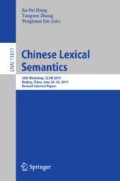Abstract
Negation in Mandarin is a field that has been substantially studied, but researches on the negation of dialects are relatively lacking. This article conducts an analysis into the negation marker mei in Northeastern Mandarin and finds three different types of mei, including mei1, a verbal negator complementary to bu, mei2, an unaccusative intransitive verb which is characteristic in this dialect but has rarely been mentioned in previous researches, and mei3, a telic and static aspectual negator which involves a tone sandhi pattern. The tone sandhi of mei3 in Northeastern Mandarin has something to do with the 4-tone-transformation in Mandarin and can be extended to other negators and even some numerals.
Access this chapter
Tax calculation will be finalised at checkout
Purchases are for personal use only
Notes
- 1.
Mei2 is not included as an independent entry in dictionaries of Standard Mandarin, and speakers of other Mandarin dialects such as Beijing Mandarin do not have this usage but would use a specific verb such as diu (丢, “to lose”) instead.
References
Li, C.N., Thompson, S.A.: Mandarin Chinese - A Reference Functional Grammar. University of California Press, Berkeley (1981)
Chao, Y.-R.: A Grammar of Spoken Chinese. The Commercial Press, Beijing (2011)
Yin, S.: Dongbei guanhua de foudingci [The Negative Words in Northeastern Mandarin]. In: Wang, G. (ed.) Hanyu fangyan yufa yanjiu – dier jie guoji hanyu fangyan yufa xueshu taolunhui lunwenji [Research on Chinese Dialects - Proceedings of the 2nd International Chinese Dialect Grammar Workshop], pp. 399–417. Central China Normal University Press, Wuhan (2007)
Jing, Y.: Qianxi dongbei fangyan zhong de “mei” [On “mei” in Northeastern dialect]. Modern Commun. 2, 28–29 (2015)
Ernst, T.: Negation in Mandarin Chinese. Nat. Lang. Linguist. Theory 13, 665–707 (1995)
Levin, B., Rappaport, M.: Nonevent -er nominals: a probe into argument structure. Linguistics 26, 1067–1083 (1988)
Lin, J.-W.: Aspectual selection and negation in Mandarin Chinese. Linguistics 41, 425–459 (2003)
Li, M.: Negation in Chinese. Shanghai Foreign Language Education Press, Shanghai (2007)
Smith, C.S., Erbaugh, M.S.: Temporal interpretation in Mandarin Chinese. Linguistics 43, 713–756 (2005)
Shi, Y., Li, C.N.: A History of Grammaticalization in Chinese - Motivations and Mechanisms of Evolution of Chinese Morpho-Syntax. Peking University Press, Beijing (2001)
Zhu, D.: Yufa jiangyi [Lecture Notes on Grammar]. The Commercial Press, Beijing (1982)
Park, J.K.: Cong leixingxue de jiaodu kan hanyu foudingci “mei” de chansheng yu fazhan [On the Emergence and Development of the Chinese Negator “mei”]. In: Department of Chinese Language and Literature, Fudan University (ed.) 2014 nian “yuyan de miaoxie yu jieshi” guoji xueshu yantaohui lunwenji [Proceedings of 2014 International Workshop on the Description and Interpretation of Language], pp. 81–84 (2014)
Zhang, F.: Qiantan dongbei fangyan zhong de sishengbieyi xianxiang [On the 4-tone-transformation in Northeastern dialect]. Songliao J. 1, 83–85 (1989)
Zhang, Z.-S.: Tone and tone sandhi in Chinese. Doctoral dissertation, The Ohio State University (1988, unpublished)
Li, S.: Dongbei fangyan zhong de “méi mèi méi” chuyi [On “méi mèi méi” in Northeastern dialect]. J. Mudanjiang Normal Univ. 4, 90, 93 (2013)
Zhu, D.-X.: A preliminary survey of the dialectal distribution of the interrogative sentence patterns V-neg-VO and VO-neg-V in Chinese. J. Chin. Linguist. 18, 209–230 (1990)
Author information
Authors and Affiliations
Corresponding author
Editor information
Editors and Affiliations
Rights and permissions
Copyright information
© 2020 Springer Nature Switzerland AG
About this paper
Cite this paper
Wei, M. (2020). The Negation Marker mei in Northeastern Mandarin. In: Hong, JF., Zhang, Y., Liu, P. (eds) Chinese Lexical Semantics. CLSW 2019. Lecture Notes in Computer Science(), vol 11831. Springer, Cham. https://doi.org/10.1007/978-3-030-38189-9_15
Download citation
DOI: https://doi.org/10.1007/978-3-030-38189-9_15
Published:
Publisher Name: Springer, Cham
Print ISBN: 978-3-030-38188-2
Online ISBN: 978-3-030-38189-9
eBook Packages: Computer ScienceComputer Science (R0)

